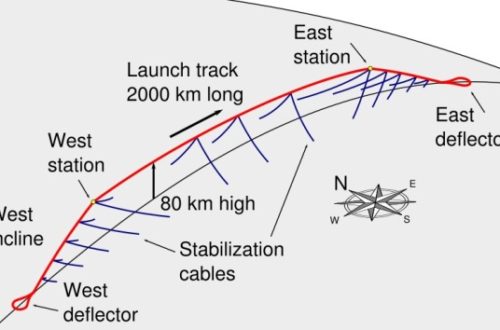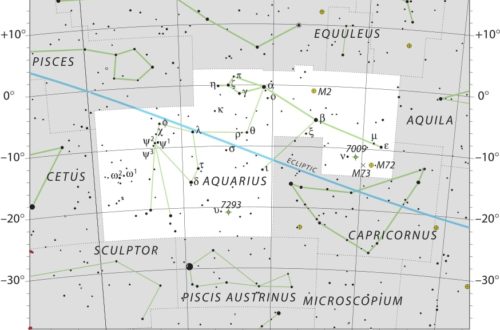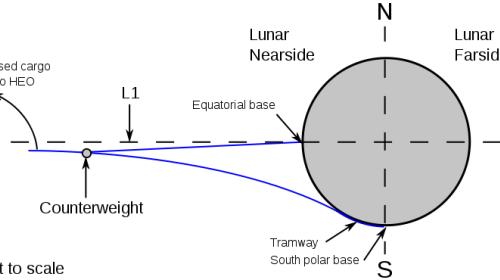Stargazing Calendar for April 2024
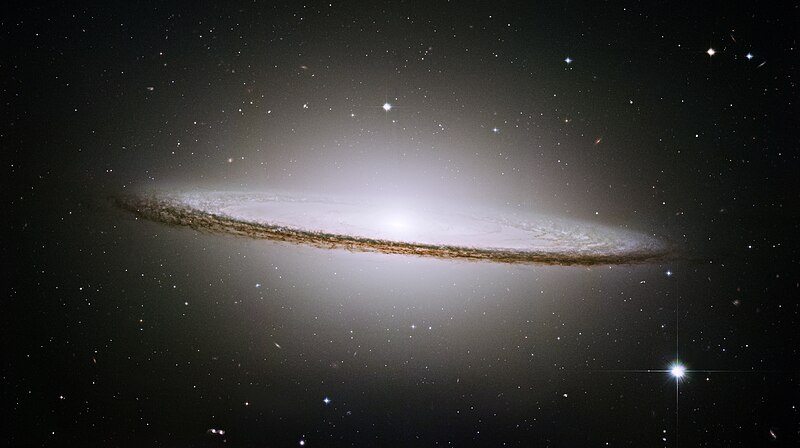
Looking for the April 2025 stargazing calendar?
Discover the wonders of the night sky this April 2024 with stargazing events ranging from mesmerizing planetary conjunctions to a total solar eclipse. Prepare for captivating encounters with the comet 12P/Pons-Brooks or the Lyrid meteor shower.
Whether you’re a seasoned astronomer or a curious novice, get ready to be enchanted by the celestial splendor awaiting you in the vast expanse above. Join us as we unveil the celestial spectacle of stargazing this April 2024, where every night holds a new cosmic marvel to behold.
Would you like to be notified of stargazing events?
List of Meteor Showers in April 2024
- Antihelion Source: Start on December 10; multiple peaks; end September 10.
- Lyrids: Start on April 16; peak on April 22; end on April 25.
- π-Puppids: Start on April 15; peak on April 23; end on April 28.
- η-Aquariids: Start on April 19; peak on May 5; end on May 28.
We also have a complete list of meteor showers for the entire year here.
List of Planetary Conjunctions in April 2024
- Conjunction of Venus and Neptune in Pisces on April 3.
- Conjunction of the Moon and Mars in Aquarius on April 6.
- Conjunction of the Moon and Saturn in Aquarius on April 6.
- Conjunction of the Moon and Venus in Pisces on April 6.
- Conjunction of the Moon and Jupiter in Aries on April 10.
- Conjunction of Saturn and Mars in Aquarius on April 11.
- Conjunction of Jupiter and Uranus in Aries on April 20.
- Conjunction of Mars and Neptune in Pisces on April 23.
April 2: The Sombrero Galaxy at its highest point in the sky
The Sombrero Galaxy, also known as Messier 104 (M104) or NGC 4594, is a peculiar galaxy of unclear classification located in the constellation of Virgo. (See featured image at the top of this article.) It gets its name from its distinctive appearance resembling a Mexican hat, with a prominent central bulge surrounded by a flat, disk-like structure of stars, dust, and gas. The dark dust lane that wraps around the galaxy’s bulge gives it the appearance of a wide-brimmed hat.
The galaxy will reach its highest point in the sky at around midnight local time. It will reach apparent magnitude of 8.6, which means it will require at least a 4 inch telescope, but an 8 inch telescope is recommended to be able to distinguish the bulge from the disk. The Moon will be a 22 days old waning crescent at 44%.
The Sombrero Galaxy is slightly larger than our own Milky Way at about 100,000 light-years in diameter. It is located 31.1 million light-years away in the Virgo II Groups, a series of galaxy clusters and individual galaxies stretching out from the southern edge of the Virgo Supercluster.
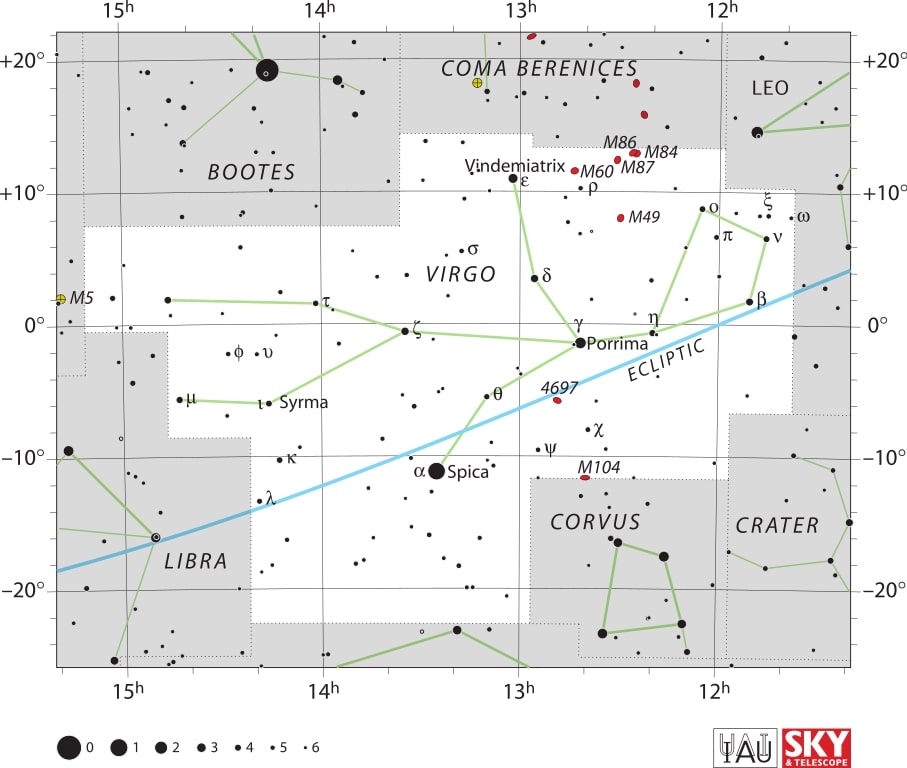
April 3: Conjunction of Venus and Neptune
Venus and Neptune will be at conjunction by sharing the same right ascension and passing within 17′ of each other.
Look for the two planets in the constellation of Pisces. Venus will be at apparent magnitude -3.9, and Neptune at 8.0. Venus will be visible to the naked eye but Neptune will require a telescope. The Moon will be a 24 days old waning crescent at 30%.
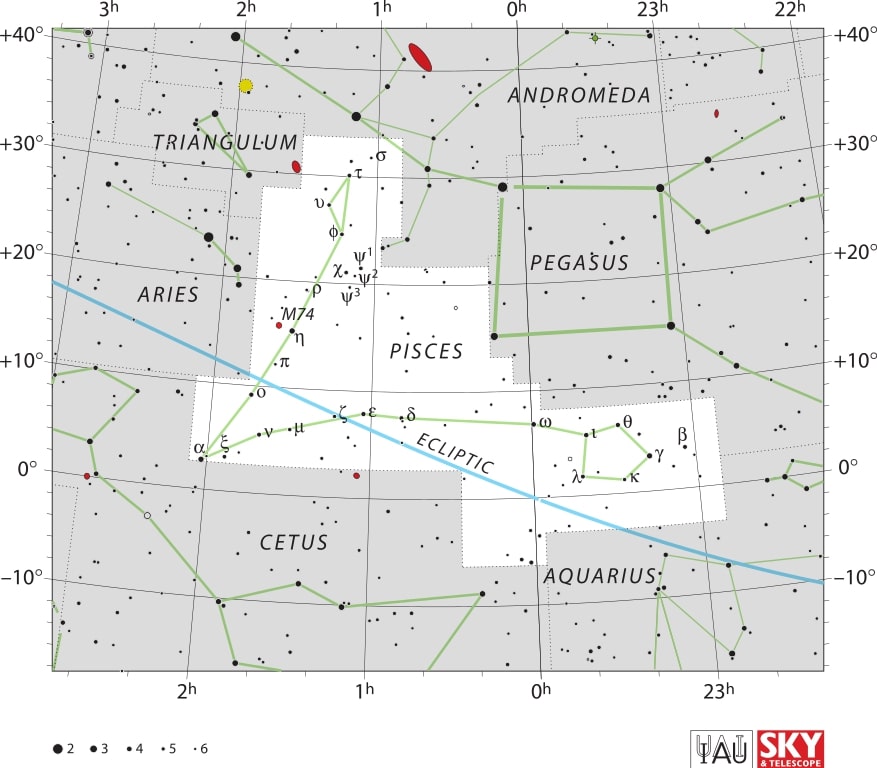
April 5: The Jewel Box cluster at its highest point in the sky
The Jewel Box, also known as NGC 4755, is a famous open star cluster located in the southern constellation of Crux (the Southern Cross). It was discovered by the French astronomer Abbé Nicolas Louis de Lacaille during his expedition to South Africa in the mid-18th century. It was later named the Jewel Box by John Herschel due to its bright and colorful stars, which give it a jewel-like appearance.
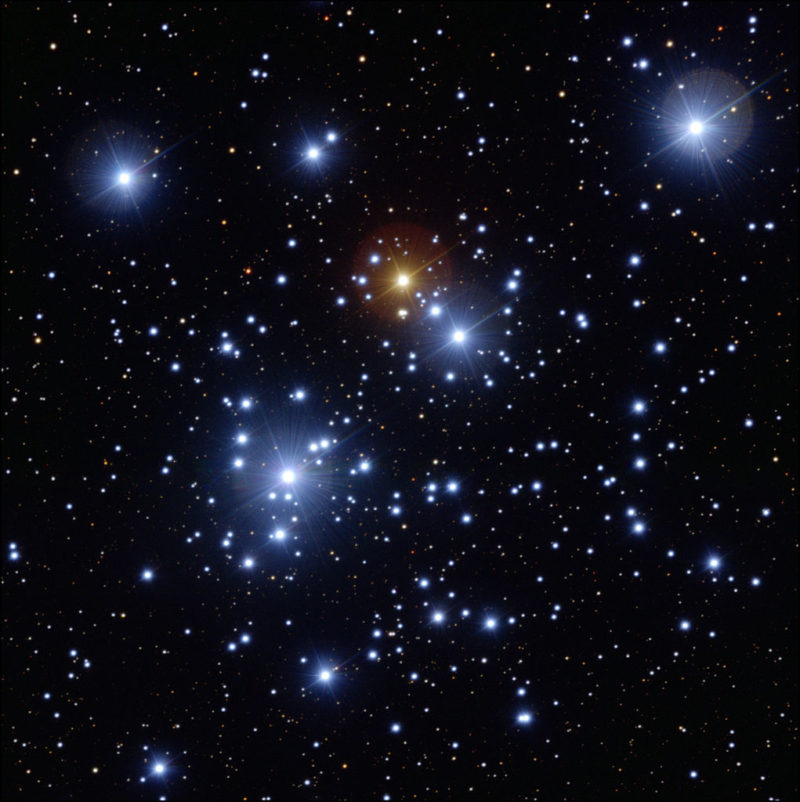
The cluster will reach its highest point in the sky at around midnight local time. It will reach apparent magnitude 4.2, which means it will be very difficult to spot with the naked eye, so a pair of binoculars or a small telescope is recommended for optimal viewing. The Moon will be a 25 days old waning crescent at 13%.
Keep in mind that this cluster is not visible to those of us in the Northern Hemisphere, as Crux is a southern constellation.
The Jewel Box contains approximately 100 stars, with many of them being young, hot, and massive. The cluster is estimated to be around 16 million years old and is located 6,440 light years away.
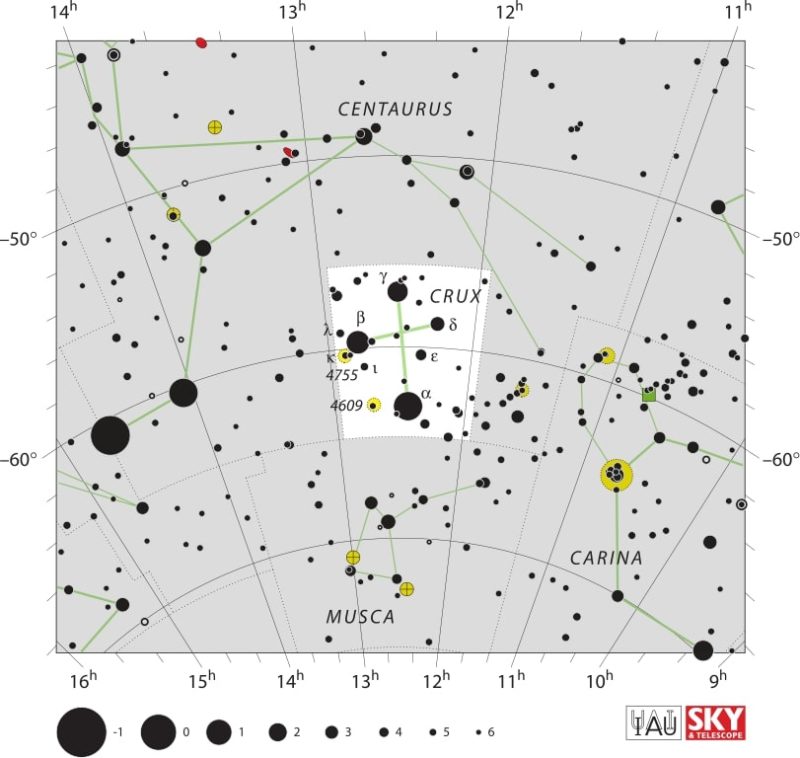
April 6: Conjunction of the Moon and Mars
The Moon and Mars will be at conjunction by sharing the same right ascension and passing within 1°58′ of each other.
Over an hour later, the two bodies will also make a close approach (appulse) reaching 1°45′ from each other, but no longer sharing the same right ascension.
Look for the two bodies in the constellation of Aquarius. The Moon will be a very thin waning crescent (6%) at 27 days old, very close to new moon. Despite this, the Moon will still be at apparent magnitude of -10.3, while Mars will be at magnitude 1.2.
Saturn and Venus will also be nearby preparing for their own conjunctions with the Moon, Saturn a few hours later and Venus the next day. Enjoy stargazing at this exquisite quadruple gathering, this month of April 2024.
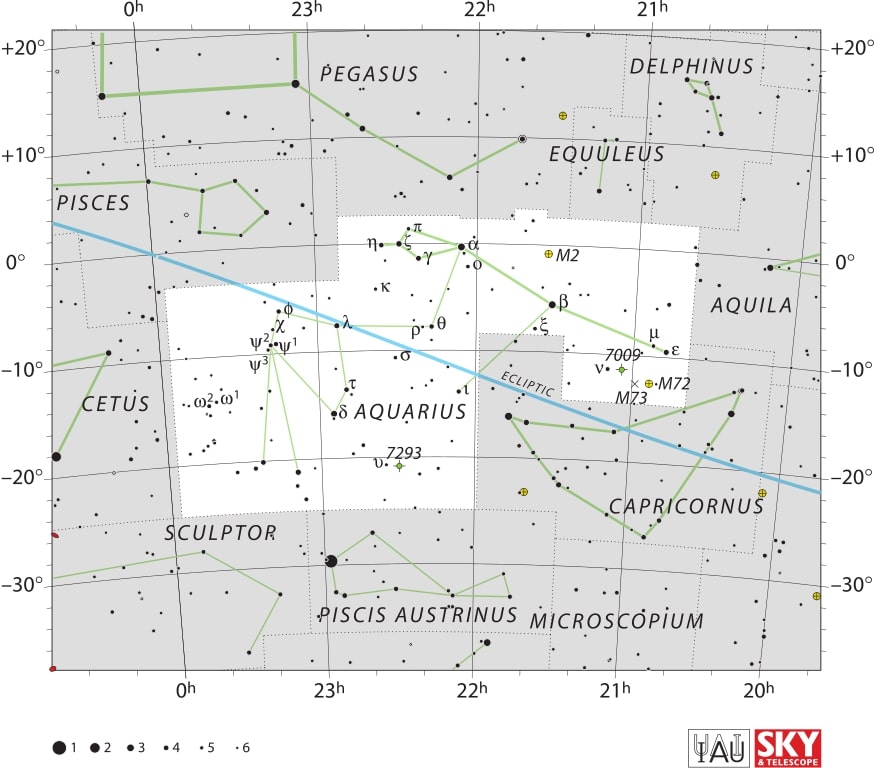
April 6: Conjunction of the Moon and Saturn
The Moon and Saturn will be at conjunction by sharing the same right ascension and passing within 1°13′ of each other.
At around the same time the two bodies will also make a close approach (appulse) reaching 1°04′ from each other, but not sharing the same right ascension.
The two celestial bodies will meet in the constellation of Aquarius with the Moon at apparent magnitude of -10.1 and Saturn at 1.0. The Moon will be a 27 days old waning crescent at 5%.
April 6: Conjunction of the Moon and Venus
The Moon and Venus will reach conjunction passing within 23′ of each other while sharing the same right ascension.
At around the same time the two bodies will also make a close approach (appulse) reaching 20.7 arcminutes from each other, but not sharing the same right ascension. In some parts of the world this distance will be so close as to lead to a lunar occultation of Venus, meaning the Moon will pass in front of Venus thereby hiding it from view temporarily. If you’re in the eastern coast of North America or in Central America, you’re in luck!
The Moon will be at apparent magnitude -8.4 and Venus at magnitude -3.9 both in the constellation of Pisces. (Constellation map already displayed above, when discussing the conjunction of Venus and Neptune.) By then, the Moon would have faded to less than 1% of its size – a 28 days old waning crescent only a day away from new moon – and will not interfere with stargazing this early to middle April 2024.
April 8: Asteroid 532 Herculina at opposition
Asteroid 532 Herculina will reach opposition, when it lies opposite to the Sun in the sky. It will reach the highest point in the sky around midnight local time.
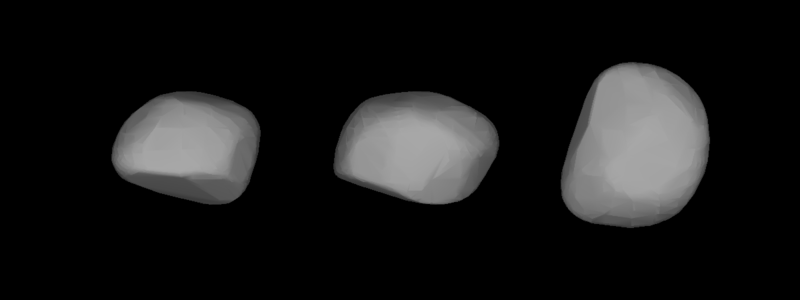
On this occasion, the asteroid Herculina will pass within 1.352 AU of Earth and reach a peak brightness of apparent magnitude 9.1. Unfortunately even at the peak, this asteroid will be too faint to observe with the naked eye. You will need at least a 4 inch telescope, which you should point towards the constellation of Bootes. The Moon will be 29 days old and a new moon and so will not interfere with observations.
Herculina is a large asteroid of the main belt at mean diameter of 167.79 km. It orbits the Sun at a semi-major axis of 2.7695 AU. (Source: NASA JPL Small-Body Database Lookup for 532 Herculina.)
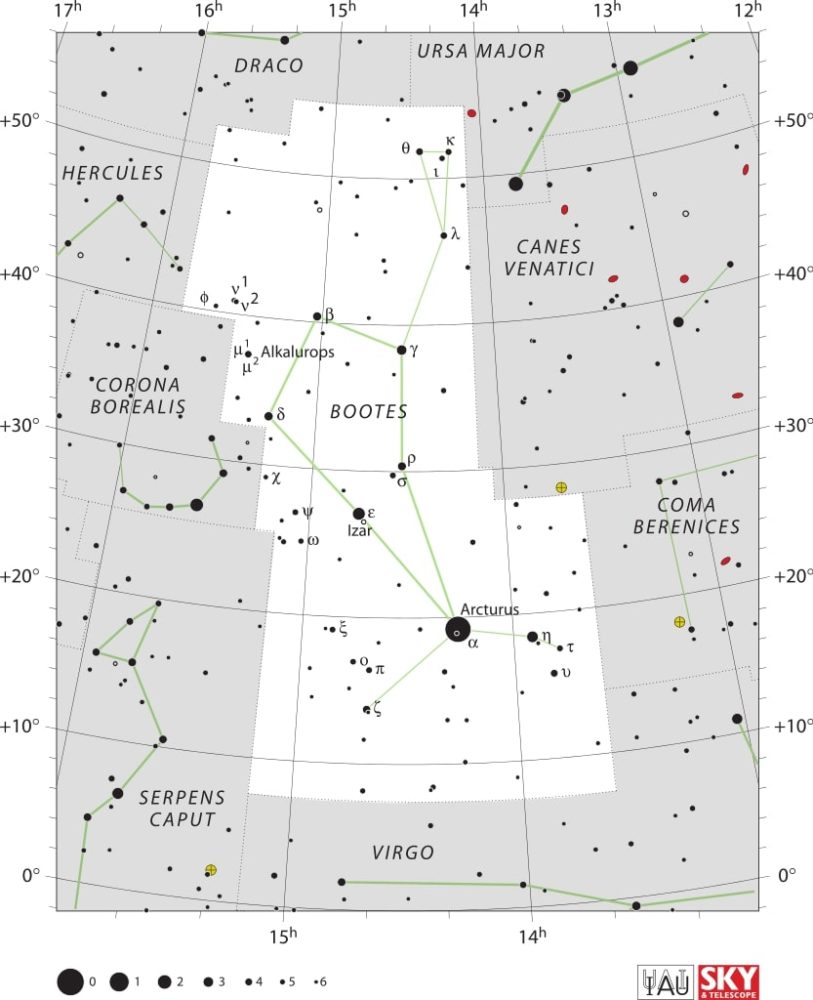
April 8: Total solar eclipse
A total solar eclipse happens when the moon fully obscures the Sun, displaying its gorgeous outer atmosphere, known as the corona. This is a rare, once-in-a-lifetime event.
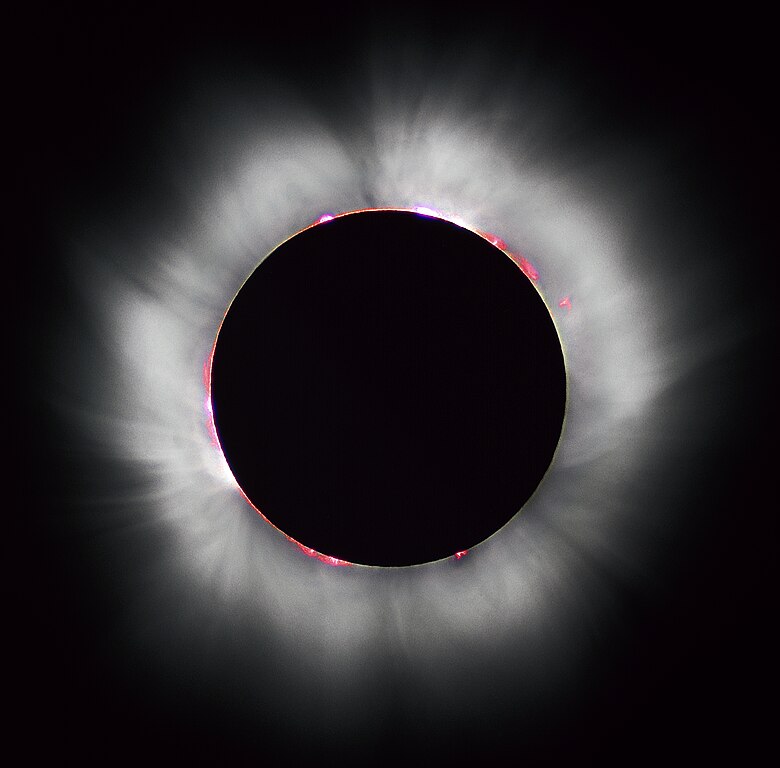
The path of totality will begin in the Pacific Ocean and move across parts of Mexico and the eastern United States and some small parts of eastern Canada (including a sliver of southern Ontario, southern Quebec including the city of Montreal, as well as parts of the maritime provinces.)
Don’t forget to keep your eyes safe with protective gear such as a solar viewer. You should also apply a filter to your telescope or binoculars if you’re planning to use those. Make sure the filters meet the ISO 12312-2 standard for safe viewing!
For more information see the chart below from NASA’s eclipses website:
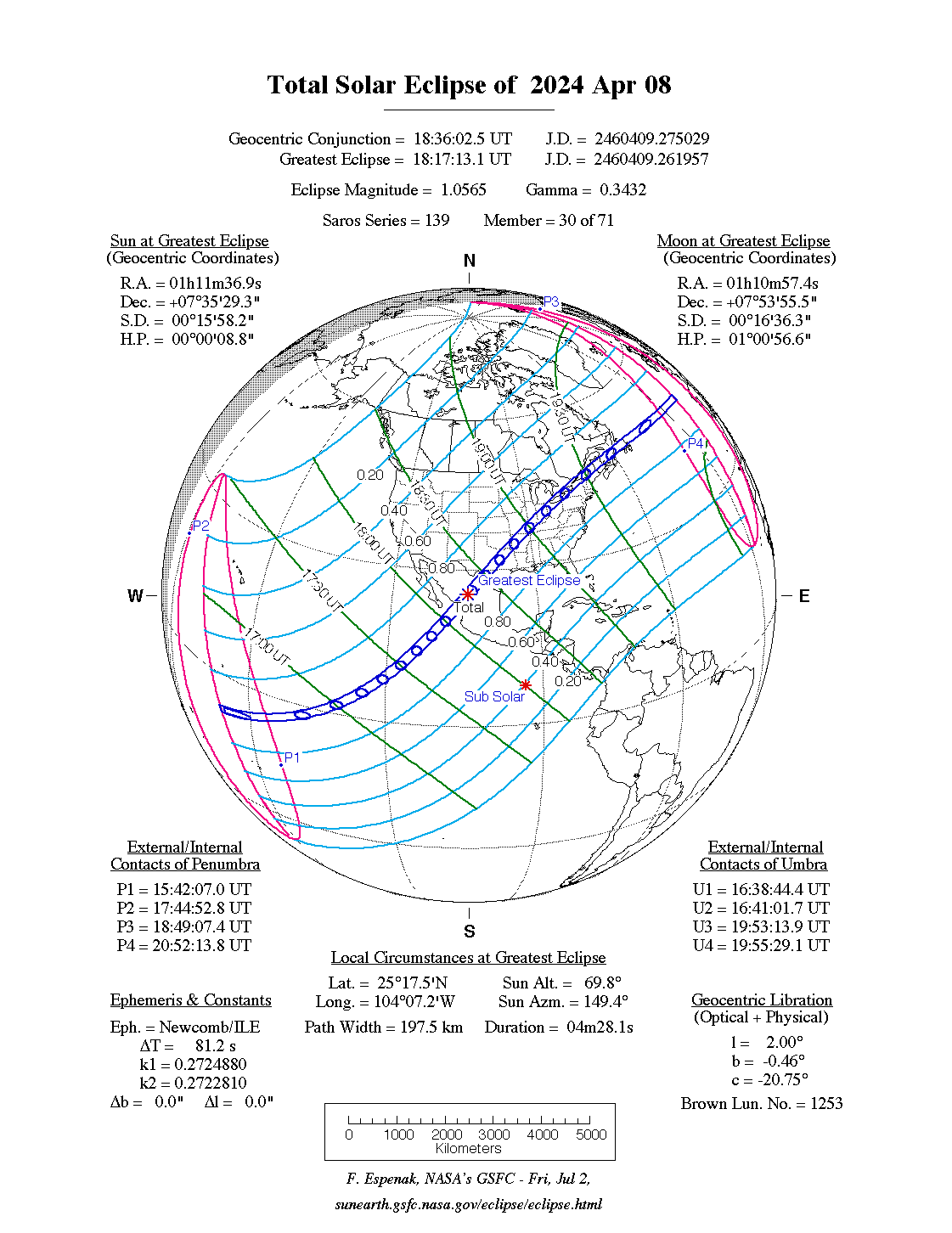
April 10: Conjunction of the Moon and Jupiter
The Moon and Jupiter will be at conjunction by sharing the same right ascension and passing within 3°59′ of each other.
The two celestial bodies will meet in the constellation of Aries with the Moon at apparent magnitude of -9.8 and Jupiter at -2.0. The Moon will be a 2 days old waxing crescent at 9%.
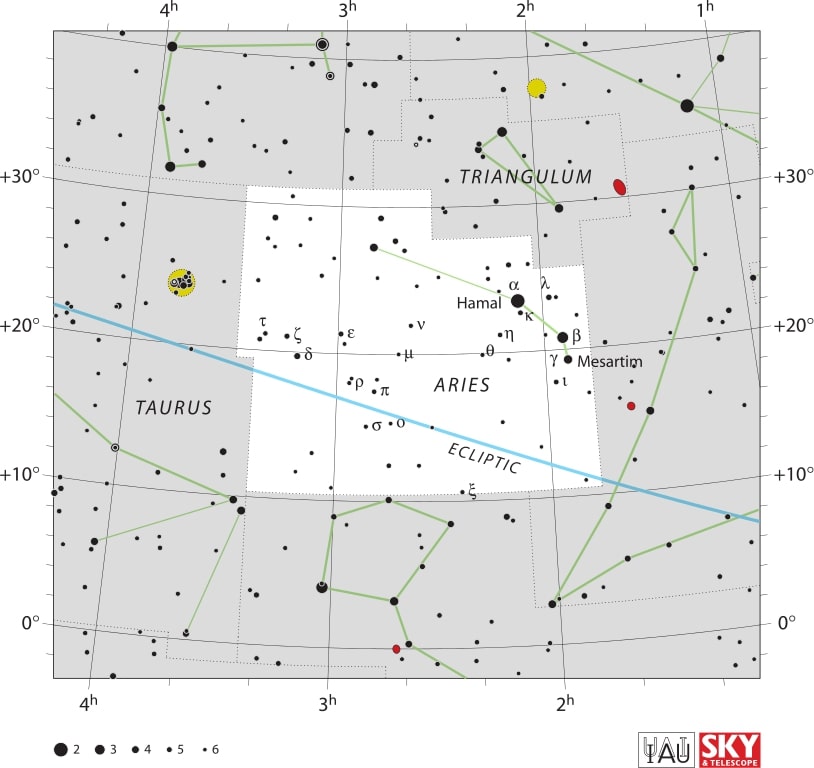
April 11: Conjunction of Saturn and Mars
Saturn and Mars will be at conjunction by sharing the same right ascension and passing within 28′ of each other.
At around the same time the two bodies will also make a close approach (appulse) reaching 26.4 arcminutes from each other, but not sharing the same right ascension.
The two planets will meet in the constellation of Aquarius with an apparent magnitude of 1.0 for Saturn and 1.2 for Mars. The Moon will be 3 days old waxing crescent at 11%. (Constellation map already displayed above, when discussing the conjunction of the Moon and Mars.)
April 11: Close approach of the Moon and the Pleiades
The Moon and the Pleiades (also known as M45 or Messier 45) will make a close approach, passing within only 19.5 arcminutes of each other.
Both objects will be in the constellation of Taurus with the Moon being at apparent magnitude -10.3; and the Pleiades at 1.3. The Moon will be a 3 days old waxing crescent at 14%.
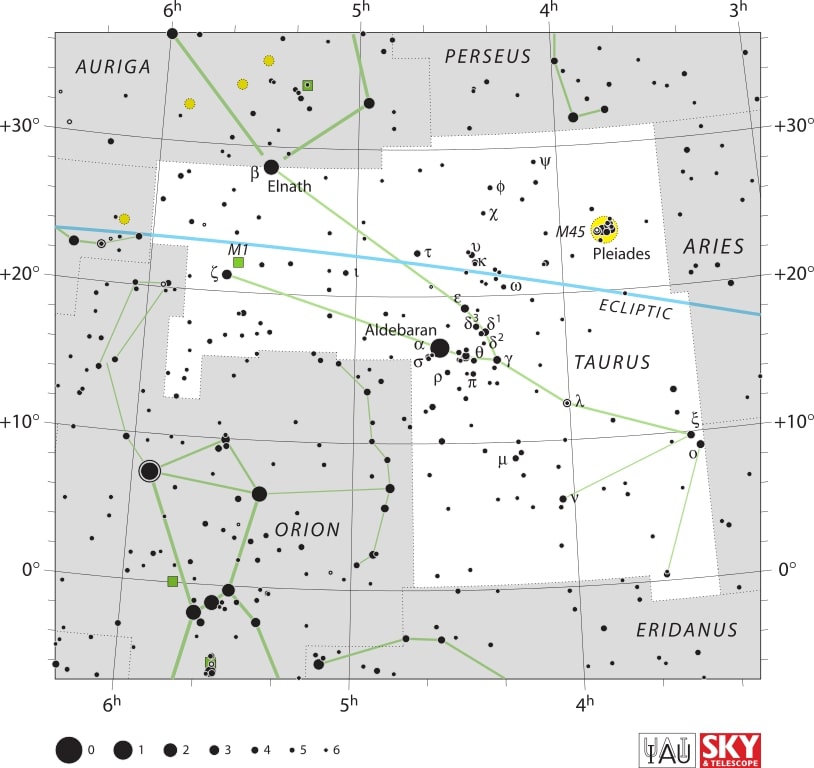
April 14: Centaurus A at its highest point in the sky
Centaurus A, also known as NGC 5128, is a prominent galaxy located in the constellation of Centaurus approximately 11 million light-years away. It is one of the closest active galaxies to Earth. It is a member of the Centaurus A/M83 Group within the Council of Giants.
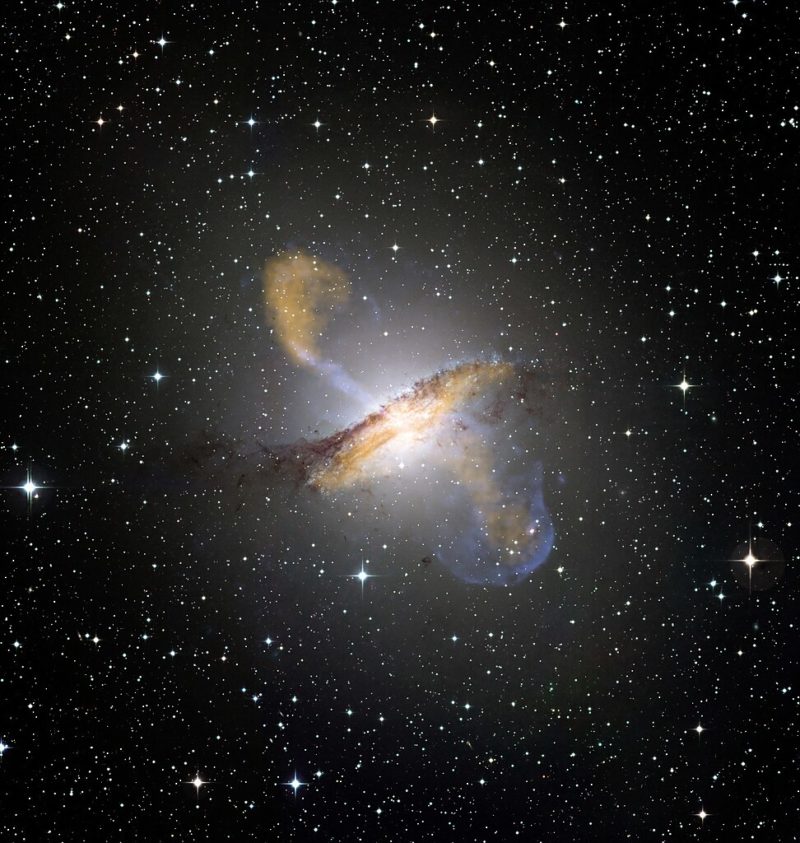
The galaxy will reach its highest point in the sky at around midnight local time. It will reach apparent magnitude 7.0, so a pair of binoculars or a small telescope is recommended for optimal viewing. The Moon will be a 6 days old waxing crescent at 36%.
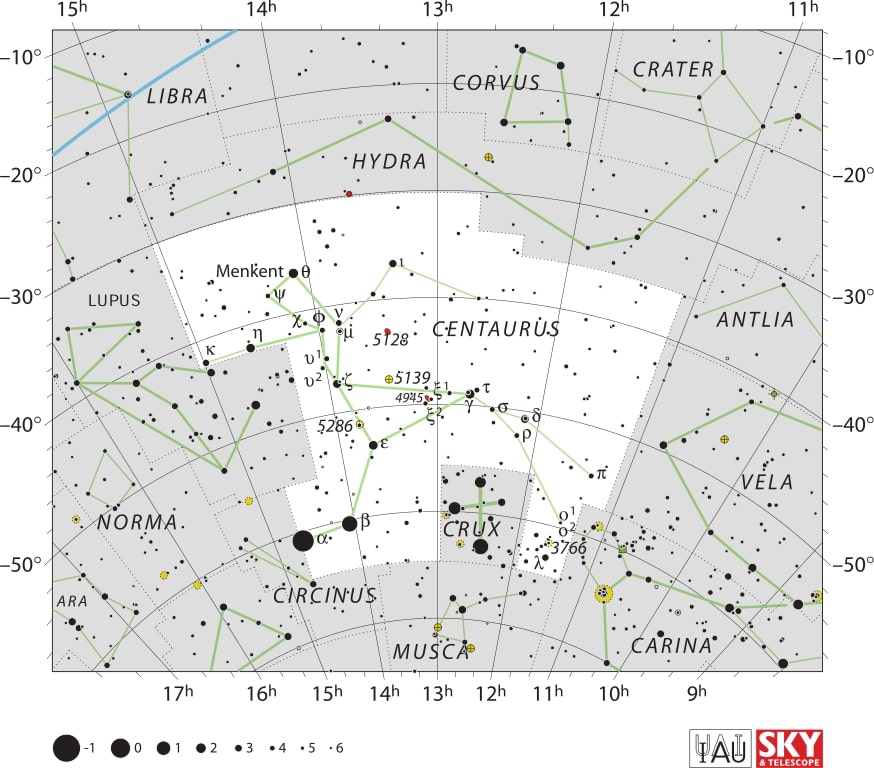
April 14: Omega Centauri cluster at its highest point in the sky
Omega Centauri (NGC 5139) is a remarkable globular cluster located in the constellation of Centaurus. It is one of the brightest and the second largest known globular cluster in the Milky Way. It is believed to have originated as the core remnant of a disrupted dwarf galaxy that has been swallowed by our own galaxy.
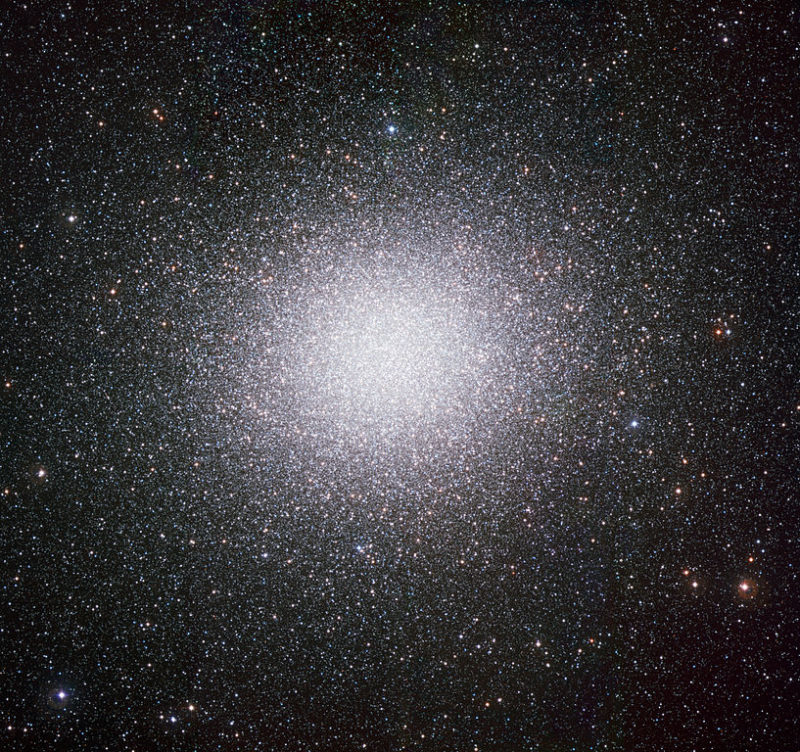
The globular cluster will reach its highest point in the sky at around midnight local time. It will reach apparent magnitude 3.6, which is technically possible to view with the naked eye under the best circumstances, but how often does that happen? I’d definitely recommend a pair of binoculars or a small telescope to see more details. Look in the constellation of Centaurus near the previously mentioned Centaurus A galaxy. The Moon will be a 6 days old waxing crescent at 36%.
April 15: Whirlpool Galaxy at its highest point in the sky
The Whirlpool Galaxy, also known as Messier 51 (M51) or NGC 5194, is a famous spiral galaxy located in the constellation Canes Venatici, approximately 23.5 million light-years away from Earth. It is one of the most recognizable and studied galaxies in the night sky.
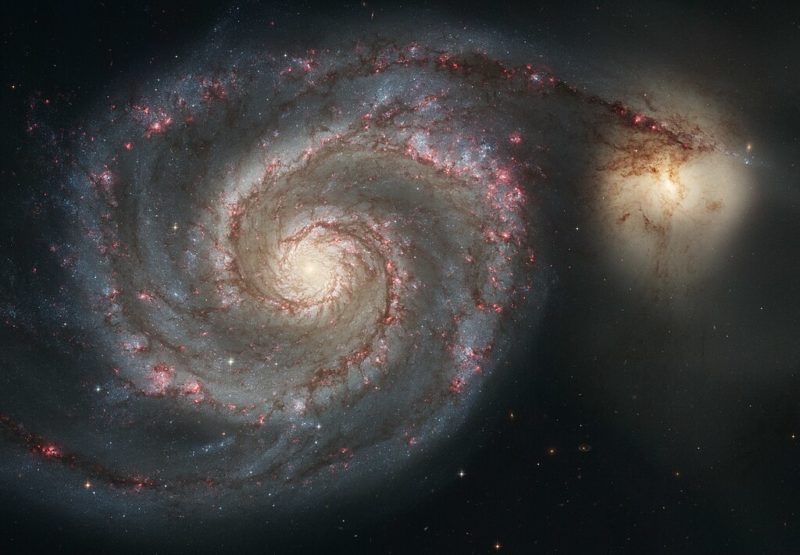
NASA, ESA, S. Beckwith (STScI), and The Hubble Heritage Team (STScI/AURA).
The galaxy will reach its highest point in the sky at around midnight local time. It will reach apparent magnitude 8.4, which means you need at least a four inch telescope. The Moon will be a 7 days old waxing crescent at 46%.
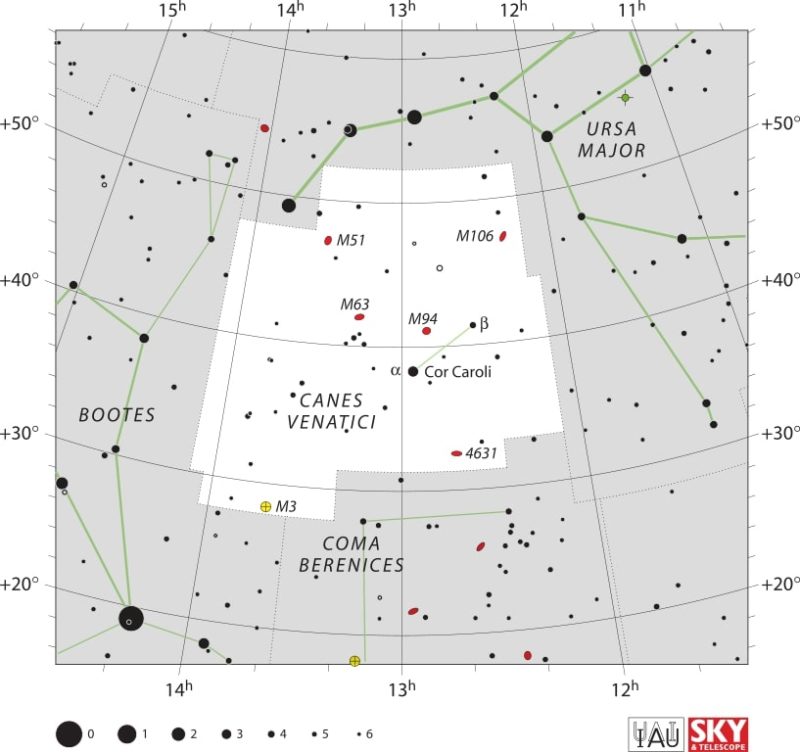
April 20: Conjunction of Jupiter and Uranus
Jupiter and Uranus will be at conjunction by sharing the same right ascension and passing within 31′ of each other.
The two planets will meet in the constellation of Aries with an apparent magnitude of -2.0 for Jupiter and 5.8 for Uranus. (Constellation map already displayed above, when discussing the conjunction of the Moon and Jupiter.) The Moon will be 12 days old waxing gibbous at 90%.
April 21: Dwarf Planet Haumea at opposition
At about midnight local time, the dwarf planet Haumea (minor-planet designation of 136108 Haumea) will reach the highest point in the sky and be opposite of the Sun. Look in the constellation of Bootes with a large telescope, as it will have an apparent magnitude of 17.3. (Constellation map already displayed above, when discussing asteroid 532 Herculina at opposition.) At around the same time Haumea will also reach its closest point to the Earth (perigee) at a distance of 49.09 AU.
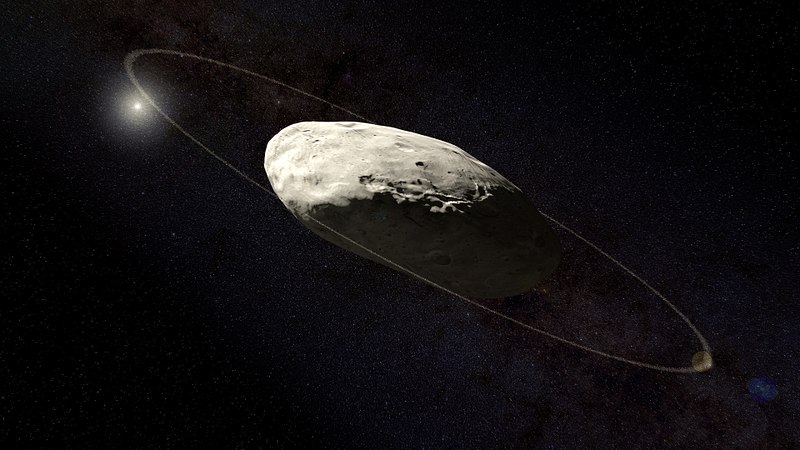
Haumea is a dwarf planet located in the outer reaches of our solar system, in the region known as the Kuiper Belt. It is the third-largest known trans-Neptunian object, after Eris and Pluto. Haumea is an elongated and relatively fast-spinning object, with an oblong shape resembling a rugby ball or elongated potato. Its shape is believed to be the result of a high rotational speed of only 3.9 hours. A ring around Haumea has also been discovered, making it the only known TNO with rings.
April 21: Comet 12P/Pons-Brooks at perihelion
The comet 12P/Pons-Brooks will reach perihelion, meaning it will reach the closest point in its orbit to the Sun at a distance of 0.78 AU. It will have an apparent magnitude of 4.6, so a standard pair of binoculars should suffice to observe this comet. Look in the constellation of Taurus. (Constellation map already displayed above, when discussing the close approach of the Moon and the Pleiades.)
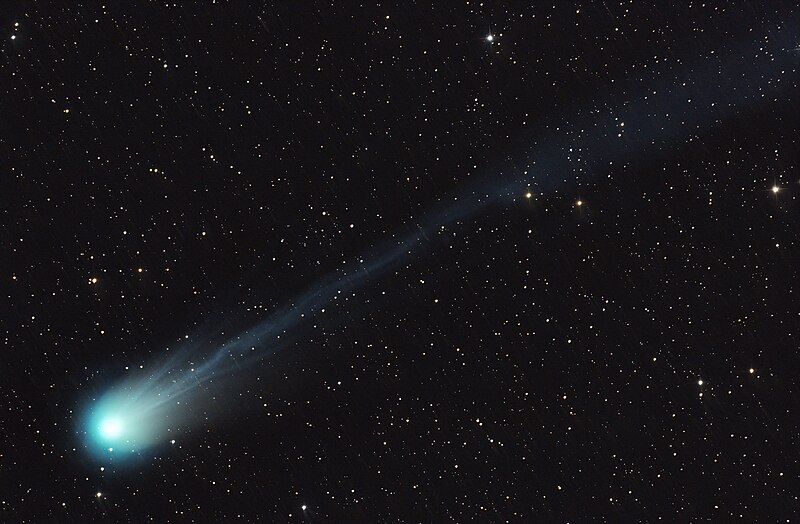
Comet 12P/Pons-Brooks, is a periodic Halley-type comet in our solar system with an orbital period of about 71 years. It was independently discovered by Jean-Louis Pons in 1812, and by William Robert Brooks in 1883.
April 22: Lyrid meteor shower peak
The Lyrids will peak this April 2024 with a zenithal hourly rate of 18 meteors if stargazing conditions are optimal. Unfortunately the Moon will interfere with observations as it will be a 14 days old waxing gibbous at 98%, close to full moon.
Some meteors may also be spotted between April 16 and April 25. They will radiate from the constellation of Lyra but near Hercules, at the speed of 49 km/s on average.
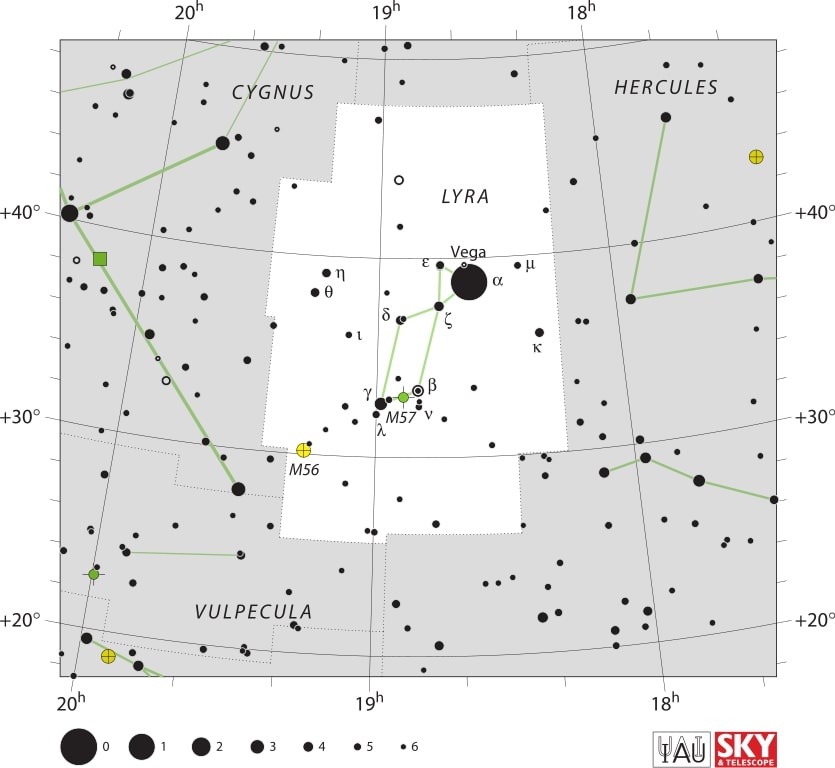
April 23: Pinwheel Galaxy at its highest point in the sky
The Pinwheel Galaxy, also known as Messier 101 (M101) or NGC 5457, is a beautiful face-on spiral galaxy located 21 million light-years away in the constellation of Ursa Major.
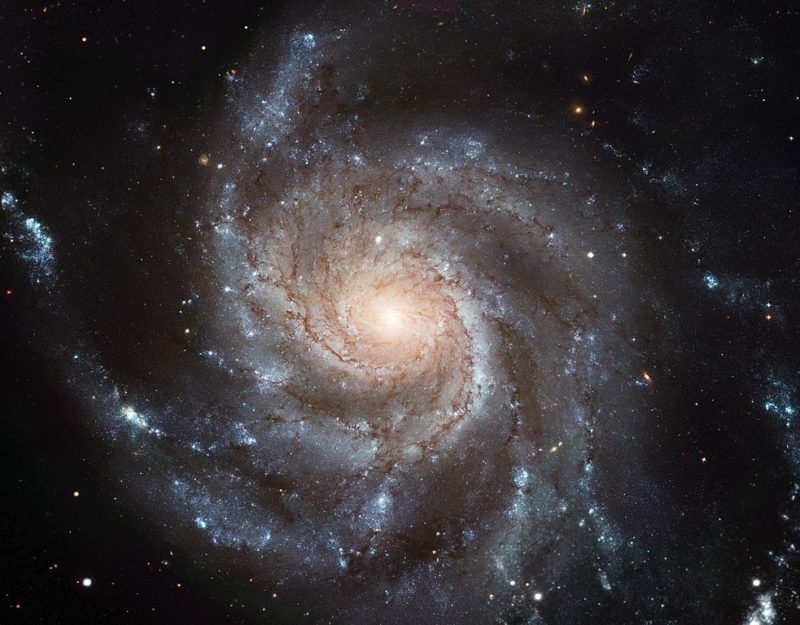
The galaxy will reach its highest point in the sky at around midnight local time. It will reach apparent magnitude 7.9, which you’ll need a telescope for optimal viewing. The Moon will be very close to a full moon (99%) at 15 days old waxing gibbous.
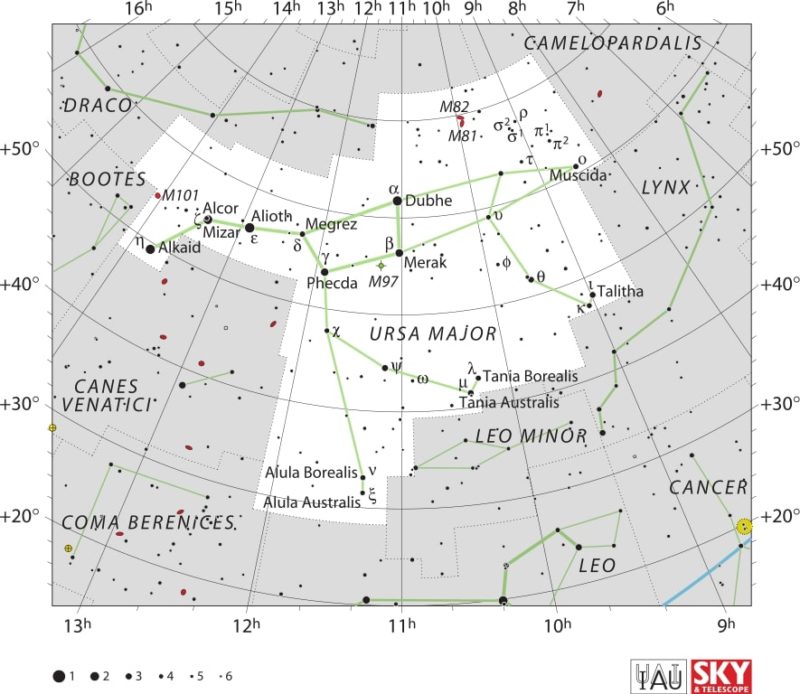
April 23: π-Puppid meteor shower peak
The Pi Puppids are a small variable meteor shower. The future of this shower is uncertain since Jupiter perturbed the orbit of the parent comet in 1999. The meteors from this shower originate from the comet 26P/Grigg-Skjellerup, which now orbits further out from Earth.
Some meteors may also be spotted between April 15 and April 28. They will radiate from the constellation of Puppis at the speed of 18 km/s on average.
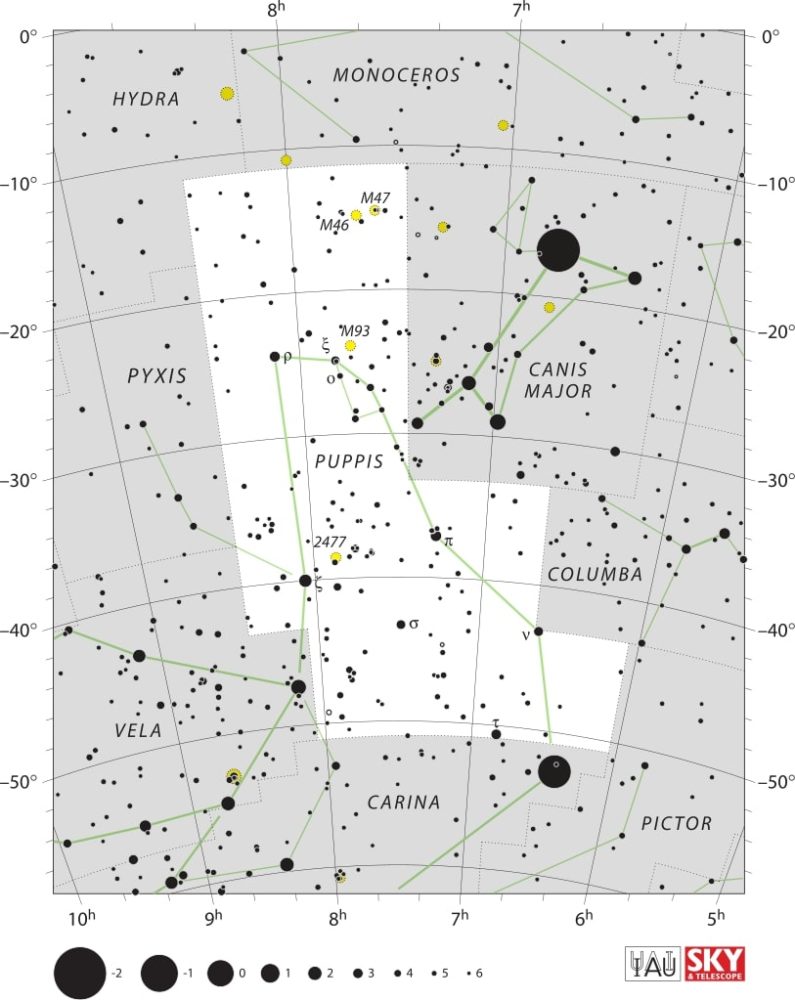
April 23: Conjunction of Mars and Neptune
Mars and Neptune will be at conjunction by sharing the same right ascension and passing within 2’14” of each other.
At around the same time the two bodies will also make a close approach (appulse) reaching 2.1 arcminutes from each other, but not sharing the same right ascension.
The two planets will meet in the constellation of Pisces with an apparent magnitude of 1.1 for Mars and 7.9 for Neptune. (Constellation map already displayed above, when discussing the conjunction of Venus and Neptune.) The Moon will be 21 days old waning gibbous at 69%.
Moon Phases in April 2024
As you know, the Moon has a big impact on the visibility of celestial bodies and astronomical events in the night sky. So to help you with stargazing, here’s a calendar of the phases of Moon for this month of April 2024:
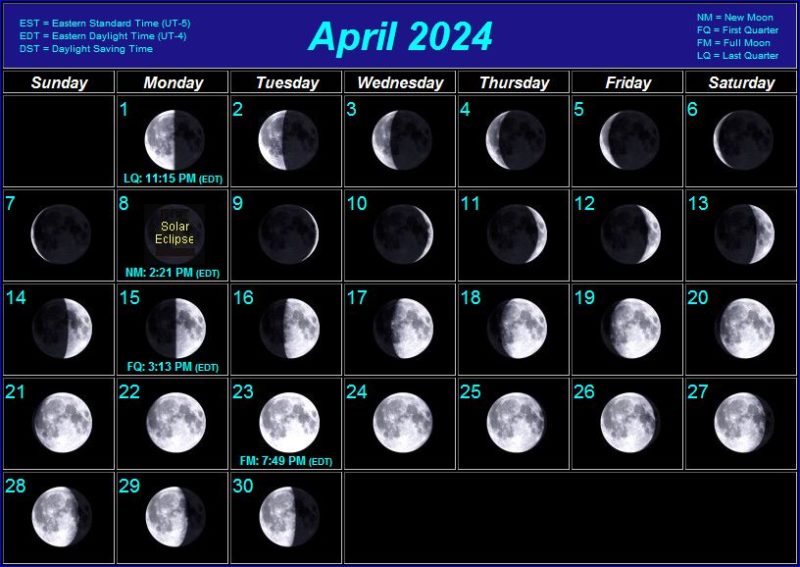
Positions of the Planets in April 2024
Mercury: The closest planet to the Sun can be seen at dawn and dusk travelling across the constellation of Pisces. This planet, being the closest to the Sun, will appear to move quickly in the night sky and its position will change in the following weeks.
Venus: The sister planet can be seen travelling across the constellation of Aquarius and then Pisces. Just like Mercury, Venus can only be seen at dawn and dusk.
Mars: The red planet can be seen in the constellation of Aquarius and then Pisces.
Jupiter: The gas giant is visible in the constellation of Aries. Jupiter can easily be spotted with the naked eye, even in highly illuminated cities.
Saturn: The ringed giant can be seen with the naked eye in the constellation of Aquarius.
Uranus: The ice giant can be seen in the constellation of Aries with the use of a telescope.
Neptune: The blue giant requires a telescope pointed in the constellation of Pisces in order to be seen.
Positions of Dwarf Planets and Large Asteroids in April 2024
Ceres: The asteroid belt’s lone dwarf planet can be seen in the constellation of Sagittarius with the help of a telescope.
Vesta: This large asteroid can be seen in the constellation of Taurus with a telescope.
Pallas: The asteroid can be observed with a telescope in the constellation of Hercules.
Pluto: This distant dwarf planet can be found in the constellation of Capricornus with the help of a large telescope.
Major astronomical events next month – May 2024
- May 5: η-Aquariid meteor shower peak.
- May 8: η-Lyrid meteor shower peak.
- May 17: Asteroid 2 Pallas at opposition.
- May 19: Comet 46P/Wirtanen at perihelion.
- May 31: τ-Herculid meteor shower peak.
Conclusion
In short, this month promises an array of celestial wonders, including a total solar eclipse, the Lyrid meteor shower, and the perihelion of Comet 12P/Pons-Brooks. Don’t miss out on this extraordinary opportunity for unforgettable stargazing experiences this April 2024.
So, mark your calendars and don’t forget to subscribe to our newsletter below to receive our stargazing calendar in your mailbox. Happy stargazing!
Sources:
- Planetary ephemerides produced by NASA’s Jet Propulsion Laboratory (JPL)
- International Meteor Organization
- NASA JPL Small-Body Database Lookup
- NASA Goddard Space Flight Center Eclipse Web Site
See also:
- Previous month’s calendar: Stargazing Calendar for March 2024
- Next month’s calendar: Stargazing Calendar for May 2024
Would you like to receive similar articles by email?



